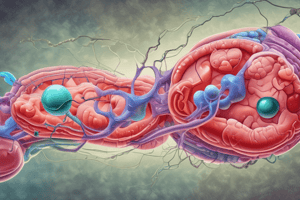Podcast
Questions and Answers
What happens to the lipoprotein remnants in the vesicle during LDL metabolism?
What happens to the lipoprotein remnants in the vesicle during LDL metabolism?
- They are converted into triglycerides.
- They are transferred to lysosomes for degradation. (correct)
- They are released back into the bloodstream.
- They are recycled into receptors.
Endocytosed cholesterol inhibits the activity of HMG CoA reductase.
Endocytosed cholesterol inhibits the activity of HMG CoA reductase.
True (A)
What is released from lysosomes during the degradation of lipoprotein remnants?
What is released from lysosomes during the degradation of lipoprotein remnants?
Free cholesterol, amino acids, fatty acids, and phospholipids
The degradation of lipoprotein remnants is conducted by lysosomal ______ enzymes.
The degradation of lipoprotein remnants is conducted by lysosomal ______ enzymes.
Match the compounds released during LDL degradation with their purposes:
Match the compounds released during LDL degradation with their purposes:
Which enzyme's activity decreases due to high cholesterol levels?
Which enzyme's activity decreases due to high cholesterol levels?
The recycling of LDL receptors is not influenced by the degradation of LDL-derived cholesterol.
The recycling of LDL receptors is not influenced by the degradation of LDL-derived cholesterol.
What effect does endocytosed cholesterol have on cellular cholesterol synthesis?
What effect does endocytosed cholesterol have on cellular cholesterol synthesis?
Which lipoprotein has the highest percentage of lipid and the lowest percentage of protein?
Which lipoprotein has the highest percentage of lipid and the lowest percentage of protein?
HDL is the most dense type of lipoprotein.
HDL is the most dense type of lipoprotein.
What primarily limits the entry of LDL cholesterol into cells?
What primarily limits the entry of LDL cholesterol into cells?
What type of lipoprotein primarily consists of mostly free cholesterol?
What type of lipoprotein primarily consists of mostly free cholesterol?
VLDL stands for very low density __________.
VLDL stands for very low density __________.
The enzyme ACAT transfers a fatty acid to cholesterol, turning it into cholesteryl ester for storage.
The enzyme ACAT transfers a fatty acid to cholesterol, turning it into cholesteryl ester for storage.
What happens to excess cholesterol if it is not immediately needed by the cell?
What happens to excess cholesterol if it is not immediately needed by the cell?
Which lipoprotein is primarily responsible for the transport of cholesterol?
Which lipoprotein is primarily responsible for the transport of cholesterol?
Match the following lipoproteins with their features:
Match the following lipoproteins with their features:
The enzyme that converts cholesterol to cholesteryl ester is called __________.
The enzyme that converts cholesterol to cholesteryl ester is called __________.
Match the following processes with their descriptions:
Match the following processes with their descriptions:
Both VLDLs and LDLs are successively denser than chylomicrons.
Both VLDLs and LDLs are successively denser than chylomicrons.
Which of the following actions is a result of increased cellular cholesterol levels?
Which of the following actions is a result of increased cellular cholesterol levels?
What is the main compositional difference between HDL and LDL?
What is the main compositional difference between HDL and LDL?
Cholesterol ester can be immediately used by the cell for structural functions.
Cholesterol ester can be immediately used by the cell for structural functions.
What is the functional result of endocytosed cholesterol on LDL receptors?
What is the functional result of endocytosed cholesterol on LDL receptors?
Which apolipoprotein is unique to chylomicrons?
Which apolipoprotein is unique to chylomicrons?
Apolipoprotein B-48 is synthesized in the smooth ER.
Apolipoprotein B-48 is synthesized in the smooth ER.
What stimulates the synthesis of lipoprotein lipase?
What stimulates the synthesis of lipoprotein lipase?
Chylomicrons are assembled with the help of the microsomal _____ transfer protein.
Chylomicrons are assembled with the help of the microsomal _____ transfer protein.
Match the following components involved in chylomicron metabolism with their roles:
Match the following components involved in chylomicron metabolism with their roles:
What happens to the size and density of chylomicrons as they circulate?
What happens to the size and density of chylomicrons as they circulate?
The apoproteins returned to HDL after chylomicron metabolism include apo E.
The apoproteins returned to HDL after chylomicron metabolism include apo E.
Where are chylomicrons released into after being packaged in secretory vesicles?
Where are chylomicrons released into after being packaged in secretory vesicles?
Which apoproteins must be obtained from circulating HDL for the release of VLDL?
Which apoproteins must be obtained from circulating HDL for the release of VLDL?
Apo C-II is required for the activation of lipoprotein lipase.
Apo C-II is required for the activation of lipoprotein lipase.
What modification occurs to VLDL as it passes through circulation?
What modification occurs to VLDL as it passes through circulation?
LDL is produced from VLDL after undergoing various __________.
LDL is produced from VLDL after undergoing various __________.
Match the lipoproteins with their characteristics:
Match the lipoproteins with their characteristics:
What happens to surface components, including apo C and E, during the modification of VLDL?
What happens to surface components, including apo C and E, during the modification of VLDL?
Triacylglycerols can be transferred from HDL to VLDL and vice versa.
Triacylglycerols can be transferred from HDL to VLDL and vice versa.
What role does cholesteryl ester transfer protein play in lipoprotein metabolism?
What role does cholesteryl ester transfer protein play in lipoprotein metabolism?
Flashcards are hidden until you start studying
Study Notes
LDL Metabolism Overview
- LDL receptors on cells can be recycled, while lipoprotein remnants are transferred to lysosomes for degradation.
- Lysosomal hydrolytic enzymes release free cholesterol, amino acids, fatty acids, and phospholipids for cellular reutilization.
Cholesterol Homeostasis Effects
- Endocytosed cholesterol influences cellular cholesterol content by:
- Inhibiting HMG CoA reductase, reducing de novo cholesterol synthesis.
- Decreasing synthesis of new LDL receptor proteins, limiting LDL cholesterol entry into cells.
- Promoting esterification by ACAT when cholesterol is not needed immediately.
Synthesis of Cholesteryl Ester
- ACAT transfers a fatty acid from CoA derivatives to cholesterol, forming cholesteryl esters that can be stored within cells.
Types and Composition of Lipoproteins
- Chylomicrons: High triglyceride (TG) content, lowest density.
- VLDL: Moderate TG content, higher density than chylomicrons.
- LDL: Rich in cholesterol, less TG than VLDL.
- HDL: High in protein and phospholipids, known as "good" cholesterol.
Lipoprotein Size and Density
- Chylomicrons are the largest and least dense lipoproteins, dominated by lipids.
- VLDL and LDL are progressively denser with higher protein-to-lipid ratios.
- HDL particles are the densest lipoproteins.
Chylomicron Metabolism
- Apolipoprotein B-48 is unique to chylomicrons, synthesized in the rough ER and glycosylated through the Golgi.
- Enzymes for lipoprotein synthesis are located in the smooth ER where proteins and lipids assemble into chylomicrons.
Regulation of Lipoprotein Lipase
- Lipoprotein lipase synthesis is stimulated by insulin, allowing degradation of triacylglycerol in chylomicrons.
- As chylomicrons lose triacylglycerol, they decrease in size and increase in density.
VLDL Modification
- VLDL is modified in circulation by lipoprotein lipase, which reduces size and increases density.
- Surface components, including C and E apoproteins, are returned to HDL while retaining apo B-100.
LDL Production from VLDL
- Modified VLDL converts into LDL, passing through intermediate-density lipoproteins (IDL) during the process.
- IDL can be endocytosed by cells using apo E as a ligand.
Cholesteryl Ester Transfer
- Triacylglycerols and cholesteryl esters can be exchanged between VLDL and HDL through cholesteryl ester transfer protein, facilitating lipid metabolism.
LDL Characteristics
- LDL particles have low triglyceride content compared to their VLDL precursors, with a high concentration of cholesterol and cholesteryl esters.
Studying That Suits You
Use AI to generate personalized quizzes and flashcards to suit your learning preferences.




